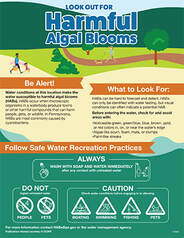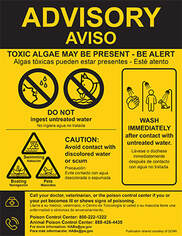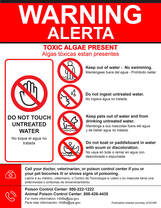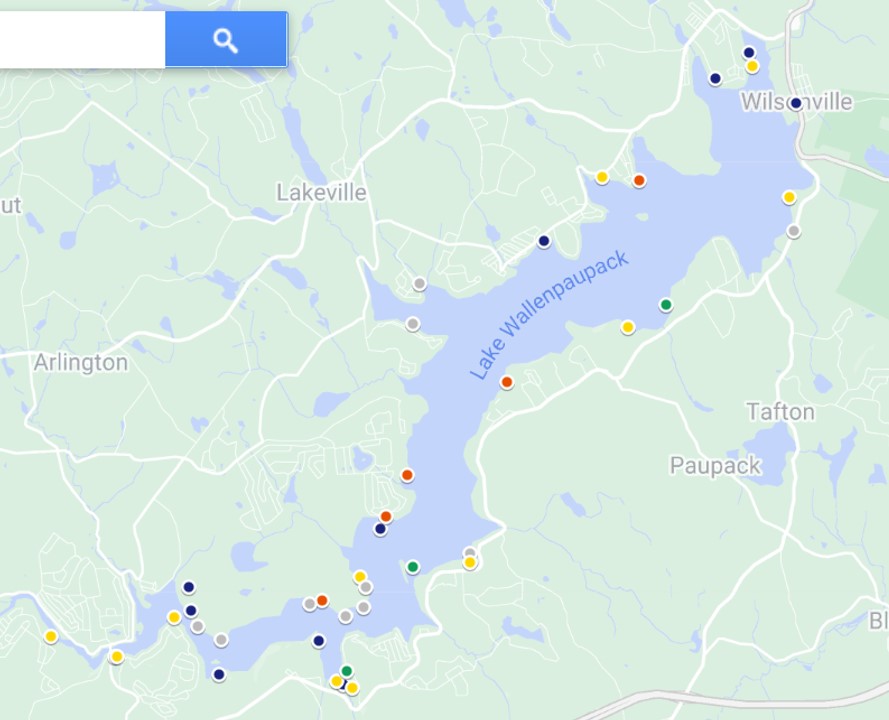Algae
Algae are a diverse group of “simple” organisms that form the base of lake foodwebs. Like terrestrial plants, algae are photosynthetic, that is they use the energy of the sun to convert carbon dioxide into sugar. Oxygen is a biproduct of photosynthesis. Therefore, algae are critical to oxygen production in lakes.
Algal Blooms - Too Much of a Good Thing Can be Bad
|
Algal blooms occur when algae populations grow quickly and become very abundant. Blooms are sometimes visible and turn the water green, blue, brown, or red. Surface blooms can look like spilled paint, surface scums, grass clippings, paint chips, or pea soup.
Algae is considered harmful when they have negative effects on lake organisms or impede the use of the lake. These types of blooms are called Harmful Algal Blooms, or HABs. Algal blooms can cause problems in lake ecosystems and for people living on or recreating in lakes. Blooms can be unsightly and can smell unpleasant. Blooms of filamentous algae can clog motors and water intakes. Blooms can also cause oxygen depletion, or anoxia. While algae produce oxygen through photosynthesis, the process of decomposition uses oxygen. So when an algal bloom senesces, or dies, the decomposition of the dead algal cells can decrease the oxygen concentration in the water, leading to oxygen stress for other lake organisms and even fish kills in some cases. HABs can also be harmful to humans and pets. Cyanobacteria (also called blue-green algae) are a type of bacteria often grouped with algae. Some types of cyanobacteria are capable of producing toxins that are harmful to people and pets. When these bacteria bloom, they can form a toxic HAB. |
Images of HABs taken from 2018-2022 from lakes in the Poconos. Photos provided by PLEON.
An introduction to HABs by Lauren Knose, PhD. Candidate at Miami University of Ohio.
|
Important facts about toxic HABs:
Regardless of toxin production, any algal bloom can threaten an ecosystem, property value, recreation, business, and water quality. What drives algal blooms and HABs to boom?
Potential factors that can contribute to algal blooms:
- There are many different kinds of cyanotoxins.
- Toxins can impair organs such as the liver and kidneys, can affect the nervous system, and may cause skin irritation in humans.
- Not all HABs are toxic and not all toxic HABs are toxic all of the time. Cyanobacteria can switch toxin production on and off.
- Unfortunately, there is no way to visually asses if a bloom is toxic or not. Testing the water for toxins is the only way to tell if a HAB is toxic. Because there are many different type of toxins, the first step is often to identify the specific cyanobacteria present in the bloom.
Regardless of toxin production, any algal bloom can threaten an ecosystem, property value, recreation, business, and water quality. What drives algal blooms and HABs to boom?
Potential factors that can contribute to algal blooms:
- Excess nutrients (nitrogen and phosphorus) in bodies of water.
- Nutrients may be fed in to lakes through runoff from industry or agriculture primarily from fertilizers used in plants or detergents that are dumped.
- These nutrients, nitrogen and phosphorus, are limiting nutrients for most life, even humans! This gives cyanobacteria and other algae an opportunity to take advantage of nutrient rich waters to grow and bloom!
- Warm lake temperatures.
Visible HABs are not common in Lake Lacawac, likely because of the relatively dark water and low nutrient content. However, HABs routinely occur in Lake Wallenpaupack, most notably in 2019 and 2020.
Several researchers working at Lacawac are studying cyanobacteria, bloom dynamics, and HAB response strategies in the Pocono region.
Several researchers working at Lacawac are studying cyanobacteria, bloom dynamics, and HAB response strategies in the Pocono region.
|
Learn more about HAB research at Lacawac, the Ohio River, and Lake Erie in this Live From The Field presentation featuring Lauren Knose and other field station researchers. Note: the Lacawac portion starts at time stamp 12:27.
|
Learn more about a survey of HABs in Pocono lakes during 2019.
|
Living with HABs:
How to assess risk, Warnings, Advisories, and What You Can Do to Help
|
When visiting your local lake, look out for advisory and warning signs that may be found at your lake. It is recommended to avoid contact with water that may have a harmful algal bloom.
Some observations of potential HABs may include:
If you suspect a HAB:
If contact or ingestion with water occurs for either a pet or human:
|
Live Near Lake Lacawac or Wallenpaupack and Want to Do More? Join PLEON's Citizen Science Project!
|
The Pocono Lakes Ecological Observatory Network, or PLEON, is Lacawac Sanctuary's lake monitoring and education program. PLEON seeks to better understand lakes within the Pocono region and to help lake communities become effective lake stewards. PLEON has a citizen-led, volunteer water quality monitoring program on Lake Wallenpaupack. This program is a great way to get involved in lake stewardship and HAB monitoring.
Walllenpaupack is a cornerstone of tourism and recreation in the Pocono region. PLEON's Water Quality in Action program trains volunteers to collect water quality data and to visually assess algal conditions off their Wallenpaupack boat or dock. Volunteers and PLEON interns currently monitor 30 sites along the shoreline of this vitally important natural resource. |
If interested in helping with this project, contact the Director of Science and Research at Lacawac Sanctuary, Beth Norman, at: [email protected].
More Resources on HABs
For more information on HABs:
More HAB Videos:
|
To learn more about the history and origin, identification in the field, unique morphology, growth of colonies, specialization of cells in colonies, lab applications, and predation of cyanobacteria watch this episode of Pondlife published by the American Museum of Natural History! Algae collected in the video come from ponds in New York City.
|
Special look at algal blooms in Lake Erie and consequences from blooms: half a million people were left without usable water due to an algal bloom. For more information on this particular Great Lake, its blooms, and ecological impacts of HABs across the United States watch this video published by NBC News Learn.
|
For more information on the chemistry of cyanotoxins and harmful algal blooms check out this video published by Reactions!
|
Resources Used:
Title image: https://www.deq.ok.gov/state-environmental-laboratory-services/environmental-public-health-information/harmful-algal-blooms/what-are-cyanobacteria/
https://eol.org/docs/discover/algae
https://carnegiescience.edu/news/what-can-plants-learn-algae
https://www.britannica.com/science/algae
https://www.dep.pa.gov/Business/Water/HABs/Pages/default.aspx
https://eol.org/docs/discover/algae
https://www.livescience.com/54979-what-are-algae.html
https://www.aquaticbiologists.com/planktonic-algae/ https://www.clemson.edu/extension/water/stormwater-ponds/images/aquatic_plants/euglena_sanguinea_bloom.JPG
https://scx2.b-cdn.net/gfx/news/2021/inside-the-world-of-ti.jpg
https://oceanservice.noaa.gov/facts/kelp-forest.jpg
https://www.deq.ok.gov/wp-content/uploads/state-environmental-laboratory-services/Microscope_BGA_2-1200x411.jpg
https://www.johnson.k-state.edu/images/Algae%201.jpg
https://www.epa.gov/nutrientpollution/harmful-algal-blooms#learn
https://www.epa.gov/nutrientpollution/effects-dead-zones-and-harmful-algal-blooms
https://www.cdc.gov/habs/prevention-control.html
May want to incorporate: https://thevirtualfield.org/video/harmful-algal-blooms/
Page created by: Alexandra Bros. 2022.
Title image: https://www.deq.ok.gov/state-environmental-laboratory-services/environmental-public-health-information/harmful-algal-blooms/what-are-cyanobacteria/
https://eol.org/docs/discover/algae
https://carnegiescience.edu/news/what-can-plants-learn-algae
https://www.britannica.com/science/algae
https://www.dep.pa.gov/Business/Water/HABs/Pages/default.aspx
https://eol.org/docs/discover/algae
https://www.livescience.com/54979-what-are-algae.html
https://www.aquaticbiologists.com/planktonic-algae/ https://www.clemson.edu/extension/water/stormwater-ponds/images/aquatic_plants/euglena_sanguinea_bloom.JPG
https://scx2.b-cdn.net/gfx/news/2021/inside-the-world-of-ti.jpg
https://oceanservice.noaa.gov/facts/kelp-forest.jpg
https://www.deq.ok.gov/wp-content/uploads/state-environmental-laboratory-services/Microscope_BGA_2-1200x411.jpg
https://www.johnson.k-state.edu/images/Algae%201.jpg
https://www.epa.gov/nutrientpollution/harmful-algal-blooms#learn
https://www.epa.gov/nutrientpollution/effects-dead-zones-and-harmful-algal-blooms
https://www.cdc.gov/habs/prevention-control.html
May want to incorporate: https://thevirtualfield.org/video/harmful-algal-blooms/
Page created by: Alexandra Bros. 2022.
Location |
|



